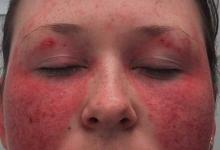Curbside Consults - January 2017 Save

Curbside Consults are cases submitted by our rheumatology colleagues as challenging therapeutic or safety issues. Answers are based on experience, with added evidence from the medical literature and published guidelines.
Case 1J. 33 yr. old male with adult onset Still’s disease from New Zealand developed fevers, rashes, arthritis, leukocytosis, pericarditis in 2004 at age 33. He was hospitalized and diagnosed with AOSD and had an excellent response to steroids. He has since had intermittent visits and occasionally has rashes, arthritis, low grade fevers that quickly respond to short courses of steroids and Plaquenil. A couple of months ago he started having more inflammatory arthritis, is seronegative with asymmetric DIP involvement. Now on 5 BID of prednisone methotrexate 20 mg qwk has been added. He has not had a complete response. Is this IL-1 dependent? Should he be on Anakinra? Or should he be treated more as a rheumatoid?
- Answer: It is quite common for patients with an onset of systemic JIA (Still's disease) that requires steroids or MTX, or anakinra to have their systemic features (fever, rash, serositis, leukocytosis) settle down only to later evolve into a chronic inflammatory polyarthritis. Nearly 30% of AOSD and systemic JIA kids will develop an inflammatory polyarthritis - and it is VERY rheumatoid-like, usually with symmetric polyarthritis, inflammatory markers and erosive disease. By definition, AOSD should be seronegative and most of these remain seronegative. (Note: Stil'ls patients NEVER develop a monoarthritis or very rarely have an asymmetric oligoarthritis). Management is the same as you would for any other active RA or active inflammatory polyarthritis. Hence, this is the one situation where TNF inhibitors excel in AOSD, as they are rarely effective in controlling the systemic features. If, along with the polyarthritis, there are systemic symptoms, I prefer to use tocilizumab, as ultimately you may be able to reduce to TCZ monotherapy. I have used anakinra to manage the “arthritis” of Still’s disease (both with early and established disease) and it has worked well in many. Nevertheless, the dosing convenience makes tocilizumab a better choice for most. I would encourage you to use what suits you and the patient best from the long list of either combo DMARDs, TNF inhibitors, abatacept, tocilizumab, anakinra, and rituximab.
Case 2J. Which Biologic can I use in a 55 yr. old woman with RA and chronic nontuberculous mycobacteria infections (MAI)?
- Answer: I would say nearly all agents and biologics could be used, EXCEPT the TNF inhibitors. TNF is needed to protect the patient from MAI and does so by generating and maintaining effective granulomas to wall off MAI. Although such patients should be treated for MAI, you can never fully eradicate the infection and thus, need to take measures to avoid reactivation. The last thing you should do is iatrogenically induce reactivation with a TNFi. The much safer option would be to choose either combination DMARDs, abatacept, tocilizumab or tofacitinib – largely because T cells, IL-6, B cells and JAK are not integral in granuloma biology. Hence, these very low risk options for someone with a mycobacterial infection. All biologics (other than anakinra and rituximab) require PPD testing – this is more a result of the trial designs during drug development and not because of the drugs biology. Since these non-TNFi agents have been approved, the number of mycobacterial infections and reactivations are a hundred to thousand times more common with TNFi than the non-TNFi agents.
Case 3J. I saw a patient today who has refractory ulcerative colitis. He was treated with adalimumab and responded immediately. He has a history of Stage 0 melanoma. What should be done with his adalimumab?
- Answer: There is some concern about using a TNF inhibitor in those with invasive melanoma, as there may be an increased risk of reactivation. Stage 0 is melanoma in situ, which has almost no risk of recurrence. For those with stage O melanoma, I would treat as if they did not have melanoma or cancer. Thus, your patient on adalimumab for ulcerative colitis can continue the biologic despite his history “excised stage 0 melanoma”. However, if the patient has an "invasive" or malignant melanoma, there is little data about negative outcomes when given a TNFi. In such instances, it may be prudent to use a nbDMARD. However, there is data from thousands of patients in nine European registries showing that invasive melanoma is NOT increased in those patients treated with TNFi (compared to DMARDs). Here are some facts on treating those with melanoma:
- RA patients have a higher risk of melanoma
- In 2010 the BSRBR showed that DMARDS had more cancer recurrences that TNFi use (but the TNFi patients had more melanoma recurrence (18% vs 0) (they didn’t say if the melanoma was melanoma in situ or invasive malignant melanoma - I would guess it was more of the former)
- 2012 RA guidelines say use RTX if you must in those with cancer (absolutely no data to warrant this expert opinion guidance)
- 2015 RA guidelines say DMARDs before biologics or tofacitinib (no mention of TNFi which has been better studied)
Case 4J. I have a 34 yr. old man with moderate to severe psoriatic arthritis (PsA); he has failed MTX and was on Remicade for years. He developed stage 2 testicular cancer and underwent surgical resection two months ago. We are awaiting further evaluation of a possible abdominal mass, but now his arthritis is flaring up badly. Otezla has not been effective. What would you do?
- I would give him a DMARD and a biologic. The 2015 ACR RA guidelines state that patients with solid tumor malignancies should be treated the same as if they did not have cancer. Recognizing the patient may be fearful of taking Remicade, you should change him to another TNF inhibitor or another biologic. I prefer a TNFi because, contrary to “expert opinion” guidelines, there are thousands of patient proving the safety of TNFi with cancer than there is for any other biologic for which there are little to no evidence (e.g., rituximab, abatacept, tocilizumab, tofacitinib, secukinumab, ixekizumab). Thus, there is no evidence that TNFi cause more solid tumor cancers or cause worse outcomes or more recurrences when there is a history of a solid tumor. If the patient was a primary nonresponder to Remicade, then you should choose a non-TNF biologic or tofacitinib and combine it with a DMARD, preferably leflunomide. If skin psoriasis is also a major problem, you should use one of the available IL-17 inhibitors. Your job is to treat the PsA and let oncology manage the testicular cancer and abdominal mass.







If you are a health practitioner, you may Login/Register to comment.
Due to the nature of these comment forums, only health practitioners are allowed to comment at this time.